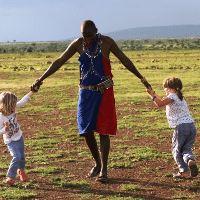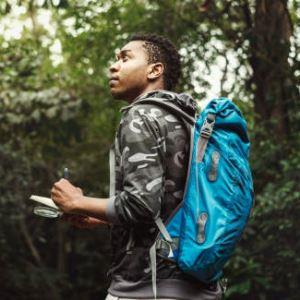 Kenya's Maasai culture continues to fascinate German tourists seeking authentic, meaningful experiences beyond the typical safari adventure. Renowned for their vibrant traditions, distinctive attire, and resilient way of life, the Maasai offer a cultural immersion that leaves a lasting impression. For German travelers, engaging with Maasai communities provides a rare window into a deeply rooted heritage that blends oral history, spirituality, and communal living. One of the most profound experiences for these visitors is participating in traditional Maasai ceremonies. Events like the "Adumu," where young warriors leap high into the air, and the "Eunoto," marking the transition from warrior to elder, offer firsthand insight into the values and social structures of the Maasai people. These ceremonies are often shared with tourists in a respectful and educational format, facilitated by local guides who explain their cultural significance. Equally enriching are village homestays, where tourists live alongside Maasai families. Here, travelers help with daily tasks such as herding livestock, collecting firewood, or preparing meals over open flames. These interactions foster a personal connection, allowing guests to appreciate the resilience and resourcefulness of the Maasai lifestyle. For many, learning Maasai customs as a German traveler becomes a transformative journey into simplicity, community, and coexistence with nature. Beyond physical activities, language and storytelling serve as vital components of the Maasai experience. Around evening campfires, elders and youth alike recount folk tales, myths, and proverbs passed down through generations. These stories often convey moral lessons and offer rich context to the tribe's values. German tourists with academic or cultural interests are especially drawn to this oral tradition, which remains central to Maasai identity. Tourism of this nature doesn't just benefit travelers it also positively impacts local communities. Revenue from cultural tourism helps fund education, healthcare, and infrastructure in Maasai villages. Moreover, respectful engagement fosters mutual understanding and helps preserve indigenous knowledge systems in an increasingly globalized world. In recent years, partnerships between German researchers and Maasai storytellers have emerged, resulting in books, documentaries, and cultural exchange programs. These initiatives not only document and preserve traditions but also empower the Maasai to share their heritage on their own terms. Through these cultural exchanges, German tourists gain far more than memories or photographs. They leave with an enriched worldview, shaped by the wisdom, resilience, and hospitality of the Maasai people.
Kenya's Maasai culture continues to fascinate German tourists seeking authentic, meaningful experiences beyond the typical safari adventure. Renowned for their vibrant traditions, distinctive attire, and resilient way of life, the Maasai offer a cultural immersion that leaves a lasting impression. For German travelers, engaging with Maasai communities provides a rare window into a deeply rooted heritage that blends oral history, spirituality, and communal living. One of the most profound experiences for these visitors is participating in traditional Maasai ceremonies. Events like the "Adumu," where young warriors leap high into the air, and the "Eunoto," marking the transition from warrior to elder, offer firsthand insight into the values and social structures of the Maasai people. These ceremonies are often shared with tourists in a respectful and educational format, facilitated by local guides who explain their cultural significance. Equally enriching are village homestays, where tourists live alongside Maasai families. Here, travelers help with daily tasks such as herding livestock, collecting firewood, or preparing meals over open flames. These interactions foster a personal connection, allowing guests to appreciate the resilience and resourcefulness of the Maasai lifestyle. For many, learning Maasai customs as a German traveler becomes a transformative journey into simplicity, community, and coexistence with nature. Beyond physical activities, language and storytelling serve as vital components of the Maasai experience. Around evening campfires, elders and youth alike recount folk tales, myths, and proverbs passed down through generations. These stories often convey moral lessons and offer rich context to the tribe's values. German tourists with academic or cultural interests are especially drawn to this oral tradition, which remains central to Maasai identity. Tourism of this nature doesn't just benefit travelers it also positively impacts local communities. Revenue from cultural tourism helps fund education, healthcare, and infrastructure in Maasai villages. Moreover, respectful engagement fosters mutual understanding and helps preserve indigenous knowledge systems in an increasingly globalized world. In recent years, partnerships between German researchers and Maasai storytellers have emerged, resulting in books, documentaries, and cultural exchange programs. These initiatives not only document and preserve traditions but also empower the Maasai to share their heritage on their own terms. Through these cultural exchanges, German tourists gain far more than memories or photographs. They leave with an enriched worldview, shaped by the wisdom, resilience, and hospitality of the Maasai people.
Summary Table of German Tourists' Experiences with Maasai Culture
| Experience Type | Activity Description | Cultural Insight Gained | Community Impact |
|---|---|---|---|
| Ceremonial Participation | Adumu dance, Eunoto ritual | Rites of passage, community values | Supports cultural preservation |
| Homestay Engagement | Cooking, beadwork, livestock care | Daily lifestyle, gender roles | Provides sustainable income to families |
| Storytelling Evenings | Fire-side tales, oral legends, songs | Oral traditions, mythology, Maasai worldview | Encourages preservation of oral history |
| Educational Collaborations | German-Maasai cultural research initiatives | Linguistic and anthropological knowledge | Builds intercultural understanding |
Immersive Cultural Encounters with Maasai Traditions in Kenya
Kenya's Maasai culture provides a rich and immersive experience for German tourists eager to move beyond traditional sightseeing. These travelers are often deeply interested in understanding the spiritual and communal life of one of East Africa's most iconic ethnic groups. Through participatory experiences in ceremonies and village activities, visitors find meaningful ways to connect with Maasai heritage. Central to this immersive journey are the traditional Maasai ceremonies. Events such as the "Adumu" (jumping dance) and "Eunoto," a rite marking a warrior's passage into elderhood, are not just performances for tourists they are vibrant expressions of Maasai identity. German visitors are welcomed into these sacred spaces with care, often accompanied by explanations from community leaders or cultural guides. This kind of exposure fosters a sense of respect and a deeper comprehension of the values that guide Maasai society. In addition to ceremonial participation, tourists often engage with Maasai families through village homestays. Here, they partake in daily chores like herding cattle, cooking local dishes such as ugali and nyama choma, or helping with water collection. These simple but intimate moments offer insights into the roles of family, gender, and nature within the Maasai worldview. The hospitality extended by hosts transforms what could be a passive experience into a genuine cultural exchange. Another powerful component of this journey is the storytelling tradition. Around evening campfires, tourists gather to listen as elders and youth recount ancestral myths, historical narratives, and moral tales. These oral traditions serve not only as entertainment but also as vessels for transmitting values and communal memory. The stories often spark thoughtful dialogue between guests and hosts, adding layers of understanding to the experience. What makes these encounters even more impactful is the lasting connection that can emerge. Some German tourists continue their involvement through partnerships with local artisans, schools, or research projects focused on language and culture preservation. These relationships extend the benefits of tourism beyond financial support, helping to ensure the longevity of cultural practices under pressure from modernization. Such moments of interaction contribute significantly to the broader goal of cultural exchange between German tourists and Maasai people. They enable both groups to learn from each other, challenge preconceived notions, and build bridges of empathy and awareness. As a result, these experiences resonate long after the trip ends, leaving both hosts and visitors transformed by the power of genuine human connection.
Traditional Maasai Ceremonies and Rituals for Foreign Tourists
German tourists who visit Kenya often find the traditional Maasai ceremonies to be deeply moving and educational. These age-old practices give travelers a window into the spiritual and communal aspects of Maasai life. Rather than mere spectacles, these rituals serve as meaningful rites that convey social values, leadership transitions, and communal unity.
- Adumu Dance (Jumping Dance): This iconic ritual, often performed by young Maasai warriors, showcases stamina, pride, and unity. German tourists are usually invited to observe and sometimes join in, which helps them understand the energy and symbolism behind the high jumps and synchronized chants.
- Eunoto Ceremony (Warrior Initiation): This elaborate rite of passage marks the transition of a warrior into elder status. It involves storytelling, singing, and blessings by the community. Tourists gain deep insight into Maasai hierarchies and generational roles.
- Blessing Rituals: Visitors sometimes witness blessings for new cattle or marriages, where elders use milk, herbs, or traditional chants. These ceremonies demonstrate the deep spiritual connection the Maasai have with nature and their livestock.
- Cultural Performances: While some performances are adapted for tourism, they still hold authentic value. They include dances, songs, and dramatized enactments of legends. Tourists appreciate the opportunity to learn about Maasai myths and values in an interactive setting.
- Traditional Dress and Ornamentation: Tourists often have the chance to try on Maasai shukas (robes) and beadwork, gaining appreciation for the significance of colors and patterns, which indicate age, status, and achievements.
- Community Participation and Exchange: Many ceremonies now include opportunities for dialogue and exchange between guests and hosts. This mutual interaction helps promote cross-cultural understanding while respecting the sacredness of the rituals.
These ceremonial experiences are not only educational for the visitors but also offer an opportunity for the Maasai to preserve and showcase their heritage. Through respectful observation and participation, tourists contribute to the sustainability of cultural tourism while enriching their own understanding of Kenya's diverse cultural landscape.
Experiencing Maasai Lifestyle through Community-Based Tourism
 For many German tourists, truly understanding Kenyan culture means going beyond the usual sightseeing and diving into the daily life of the Maasai people. Community-based tourism provides an avenue for these travelers to witness and participate in the authentic lifestyle of the Maasai, creating a two-way exchange of knowledge and tradition that leaves lasting impressions. A cornerstone of this experience is the homestay model, where tourists live among Maasai families for a few days. These stays include helping with daily chores such as fetching water, herding livestock, or preparing traditional meals like ugali and nyama choma. Through these humble but rich interactions, visitors not only learn practical skills but also observe the deeply ingrained sense of cooperation and community within Maasai households. Tourists often engage in traditional Maasai crafts, particularly beadwork, which is both a source of income and a cultural symbol. Under the guidance of skilled artisans, guests try their hand at designing intricate jewelry, gaining insight into the meaning behind each color and pattern. These activities give tourists a tactile connection to the culture, reinforcing appreciation and respect. Morning routines often start early with the herding of cattle, a core part of Maasai life. German visitors are frequently surprised by the discipline and responsibility shown by even the youngest children in these tasks. It's in these moments that the gap between Western and pastoral lifestyles narrows, opening the door to mutual understanding. Evening gatherings around a fire serve as a platform for storytelling and cultural discussion. This informal setting allows tourists to ask questions and share their own perspectives, often leading to meaningful dialogues about values, identity, and social change. Understanding Maasai rituals during German tourist trips often crystallizes in these reflective conversations, as travelers process their immersive experiences. These community-based experiences benefit both sides. Tourists leave with a richer worldview and a renewed sense of global citizenship. For the Maasai, these visits offer not only financial support but also recognition and validation of their cultural heritage. This mutual enrichment helps sustain traditions that might otherwise be overshadowed by modernization. The lifestyle exchange between German tourists and Maasai hosts is more than just a travel novelty it's a bridge between worlds built on empathy and shared human values. While the cultural backgrounds of both groups differ significantly, the interactions fostered through community-based tourism reveal remarkable common ground. These exchanges underscore the universal nature of hospitality, family bonds, and the human connection to land and tradition. Such experiences are not only emotionally enriching but also socially impactful. They often lead to friendships, collaborative projects, and even return visits, strengthening intercultural relationships over time. German tourists, in particular, leave with a deep appreciation for the Maasai's resilience and wisdom, while the Maasai communities benefit from economic opportunities and global recognition. As more travelers seek meaningful connections abroad, these kinds of grassroots encounters are likely to play an increasingly vital role in shaping the future of responsible tourism, education, and mutual cultural respect.
For many German tourists, truly understanding Kenyan culture means going beyond the usual sightseeing and diving into the daily life of the Maasai people. Community-based tourism provides an avenue for these travelers to witness and participate in the authentic lifestyle of the Maasai, creating a two-way exchange of knowledge and tradition that leaves lasting impressions. A cornerstone of this experience is the homestay model, where tourists live among Maasai families for a few days. These stays include helping with daily chores such as fetching water, herding livestock, or preparing traditional meals like ugali and nyama choma. Through these humble but rich interactions, visitors not only learn practical skills but also observe the deeply ingrained sense of cooperation and community within Maasai households. Tourists often engage in traditional Maasai crafts, particularly beadwork, which is both a source of income and a cultural symbol. Under the guidance of skilled artisans, guests try their hand at designing intricate jewelry, gaining insight into the meaning behind each color and pattern. These activities give tourists a tactile connection to the culture, reinforcing appreciation and respect. Morning routines often start early with the herding of cattle, a core part of Maasai life. German visitors are frequently surprised by the discipline and responsibility shown by even the youngest children in these tasks. It's in these moments that the gap between Western and pastoral lifestyles narrows, opening the door to mutual understanding. Evening gatherings around a fire serve as a platform for storytelling and cultural discussion. This informal setting allows tourists to ask questions and share their own perspectives, often leading to meaningful dialogues about values, identity, and social change. Understanding Maasai rituals during German tourist trips often crystallizes in these reflective conversations, as travelers process their immersive experiences. These community-based experiences benefit both sides. Tourists leave with a richer worldview and a renewed sense of global citizenship. For the Maasai, these visits offer not only financial support but also recognition and validation of their cultural heritage. This mutual enrichment helps sustain traditions that might otherwise be overshadowed by modernization. The lifestyle exchange between German tourists and Maasai hosts is more than just a travel novelty it's a bridge between worlds built on empathy and shared human values. While the cultural backgrounds of both groups differ significantly, the interactions fostered through community-based tourism reveal remarkable common ground. These exchanges underscore the universal nature of hospitality, family bonds, and the human connection to land and tradition. Such experiences are not only emotionally enriching but also socially impactful. They often lead to friendships, collaborative projects, and even return visits, strengthening intercultural relationships over time. German tourists, in particular, leave with a deep appreciation for the Maasai's resilience and wisdom, while the Maasai communities benefit from economic opportunities and global recognition. As more travelers seek meaningful connections abroad, these kinds of grassroots encounters are likely to play an increasingly vital role in shaping the future of responsible tourism, education, and mutual cultural respect.
Daily Life with Maasai Families and Traditional Homestead Stays
Experiencing the daily life of Maasai families is one of the most profound and grounding aspects of visiting Kenya for German tourists. These interactions often occur in the form of guided Maasai village tours for German tourists, which blend traditional homestays with structured cultural insights. Visitors are welcomed into family compounds, where they learn firsthand about Maasai customs, roles, and responsibilities within a communal setting. A typical day begins at dawn, often with the herding of cattle, a vital part of Maasai livelihood. Tourists are invited to join these early morning routines, gaining respect for the skills and endurance required to manage livestock across vast, open plains. Through participation in such activities, tourists understand the value placed on animals, especially cattle, as both economic assets and cultural symbols. Women often guide guests in household activities like cooking traditional meals ugali, sukuma wiki, or nyama choma. These shared cooking sessions allow German travelers to learn how food, family roles, and mealtime rituals are interwoven into daily life. In addition, guests may help with tasks like fetching water or gathering firewood, gaining appreciation for the daily responsibilities shouldered by Maasai women. Artisanal practices also form an essential part of the experience. Beadwork, in particular, is both a creative expression and a social indicator. Tourists sit alongside local artisans to craft necklaces, bracelets, and other items, while hearing stories about the meanings behind color schemes and patterns. This tactile engagement deepens cultural appreciation and creates opportunities for respectful dialogue. Evenings tend to be more relaxed but equally enriching. Around a communal fire, tourists are invited to listen to elders recount oral histories, moral tales, and personal stories from Maasai life. This storytelling offers a rare chance to hear perspectives shaped by generations of tradition. It often sparks thoughtful conversations and reveals how cultural values are passed down informally but powerfully. These guided homestay experiences offer far more than cultural observation; they invite participation, understanding, and respect. They help German tourists shed preconceptions and embrace a slower, more community-focused way of life. The knowledge gained here is not academic it is lived and felt. Visitors leave not only with souvenirs but with meaningful insights into a resilient culture that values unity, responsibility, and harmony with nature.
Language, Storytelling, and Oral History Among the Maasai People
One of the most captivating aspects of the Maasai culture for German tourists is its rich oral tradition. Language and storytelling are integral to the Maasai way of life, preserving history, values, and identity across generations. As part of their cultural exploration, German travelers often attend evening gatherings in Maasai villages where elders recount myths, moral tales, and tribal legends passed down over centuries. These storytelling sessions offer more than just entertainment they provide meaningful insights into the beliefs and social structures of Maasai society. Whether it's a tale about the origins of cattle or lessons on bravery and respect, each story reveals something profound about Maasai philosophy. Tourists often find these moments emotionally resonant and intellectually enriching. Song and dance frequently accompany these tales, adding rhythm and movement to the narratives. For German visitors, the experience offers an authentic window into the expressive nature of Maasai culture. In these informal settings, tourists are encouraged to ask questions and even share stories of their own, creating a dialogue that bridges cultural divides. Interest in Maasai storytelling has sparked several collaborations between local narrators and German cultural researchers. These efforts have resulted in the translation and publication of folk stories, as well as digital archives that aim to preserve this oral heritage. Educational institutions in both Kenya and Germany have used these materials to foster cross-cultural understanding. The rise of Kenya cultural safari itineraries for German travelers has also contributed to the popularity of these storytelling experiences. More tours now include dedicated sessions with Maasai elders, sometimes within community-run cultural centers or eco-lodges. These initiatives ensure that the benefits of tourism are shared directly with the storytellers and their communities. The oral traditions of the Maasai do more than captivate visitors they establish meaningful and lasting connections between cultures. German tourists, in particular, often find themselves deeply moved by the power of spoken word as a tool for education, emotional connection, and cultural continuity. As they sit around communal fires and listen to the rhythmic cadence of Maasai elders recounting folktales, legends, and life experiences, they gain more than just stories they absorb a philosophy of life that is oral, communal, and deeply spiritual. These exchanges allow tourists to see how language acts not just as a communication tool but as a vessel of heritage. Many leave with a newfound respect for the subtle complexities and wisdom embedded in oral storytelling. Moreover, these moments frequently spark discussions about shared human values like bravery, kindness, and respect for nature, proving that wisdom can cross language barriers. German visitors often report a deeper appreciation for their own cultural narratives after engaging with Maasai traditions, enriching both perspectives. These conversations, conducted in a spirit of mutual curiosity and admiration, foster intercultural bonds that persist long after the trip ends. Such exchanges nurture mutual respect and promote the preservation of intangible cultural heritage in a rapidly globalizing world. As modern pressures mount, these oral traditions serve as vital reminders of the importance of listening, remembering, and passing on wisdom through generations.
Maasai Folklore, Legends, and German Interest in Oral Traditions
The Maasai have long maintained a strong oral tradition that continues to captivate visitors, particularly those from Germany who seek depth and authenticity in their travel experiences. Folklore and storytelling are essential pillars of Maasai culture, preserving not only history and beliefs but also guiding values and communal identity. For German tourists, attending these storytelling sessions becomes a highlight of their cultural itinerary. Often conducted in the evenings around a crackling fire, these sessions bring together community elders and younger generations to share tales that range from heroic exploits to moral parables and spiritual beliefs. German visitors are often struck by how the oral tradition brings the community together and reinforces a shared identity. These stories serve as educational moments and build emotional resonance that deepens the overall travel experience. Song and rhythmic dance often accompany these tales, transforming them into performances that engage all the senses. This performative aspect of storytelling reveals the expressive power and layered complexity of Maasai communication. German tourists are encouraged not only to listen but also to interact sometimes even sharing aspects of their own cultural stories, making the experience a true exchange. The inclusion of storytelling is a testament to the growing recognition of intangible cultural heritage. Tour operators increasingly work with local Maasai communities to incorporate these experiences into travel programs, ensuring that both the cultural richness is preserved and that economic benefits flow directly to the storytellers and their families. These engagements go beyond passive listening. They invite German tourists to understand the symbolic language and metaphors unique to the Maasai worldview. Many travelers report that these sessions are among the most memorable parts of their journey, revealing deep philosophical and spiritual insights into a way of life that honors history, community, and nature. The interest in Maasai folklore is not just about collecting stories; it's about building bridges between cultures. The respect and curiosity that German visitors bring to these encounters help foster mutual appreciation and a deeper commitment to cultural preservation. In this way, storytelling becomes a living link between people and traditions, spanning continents and generations.



